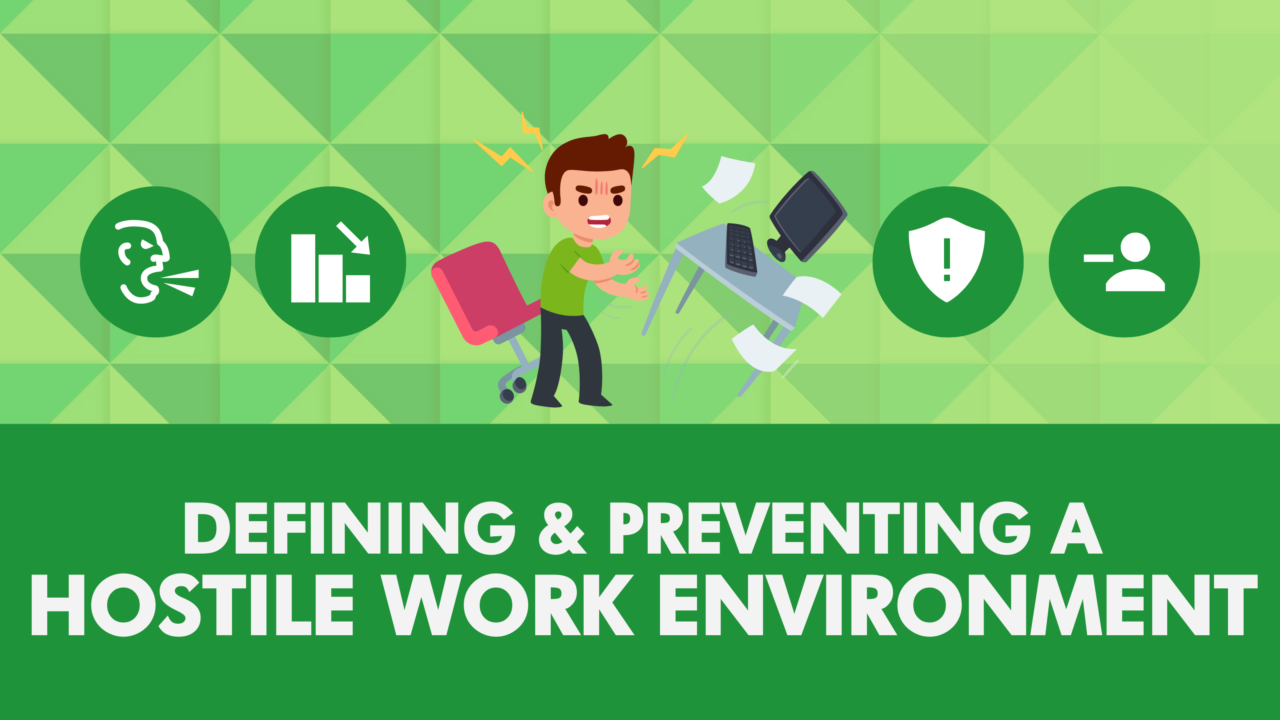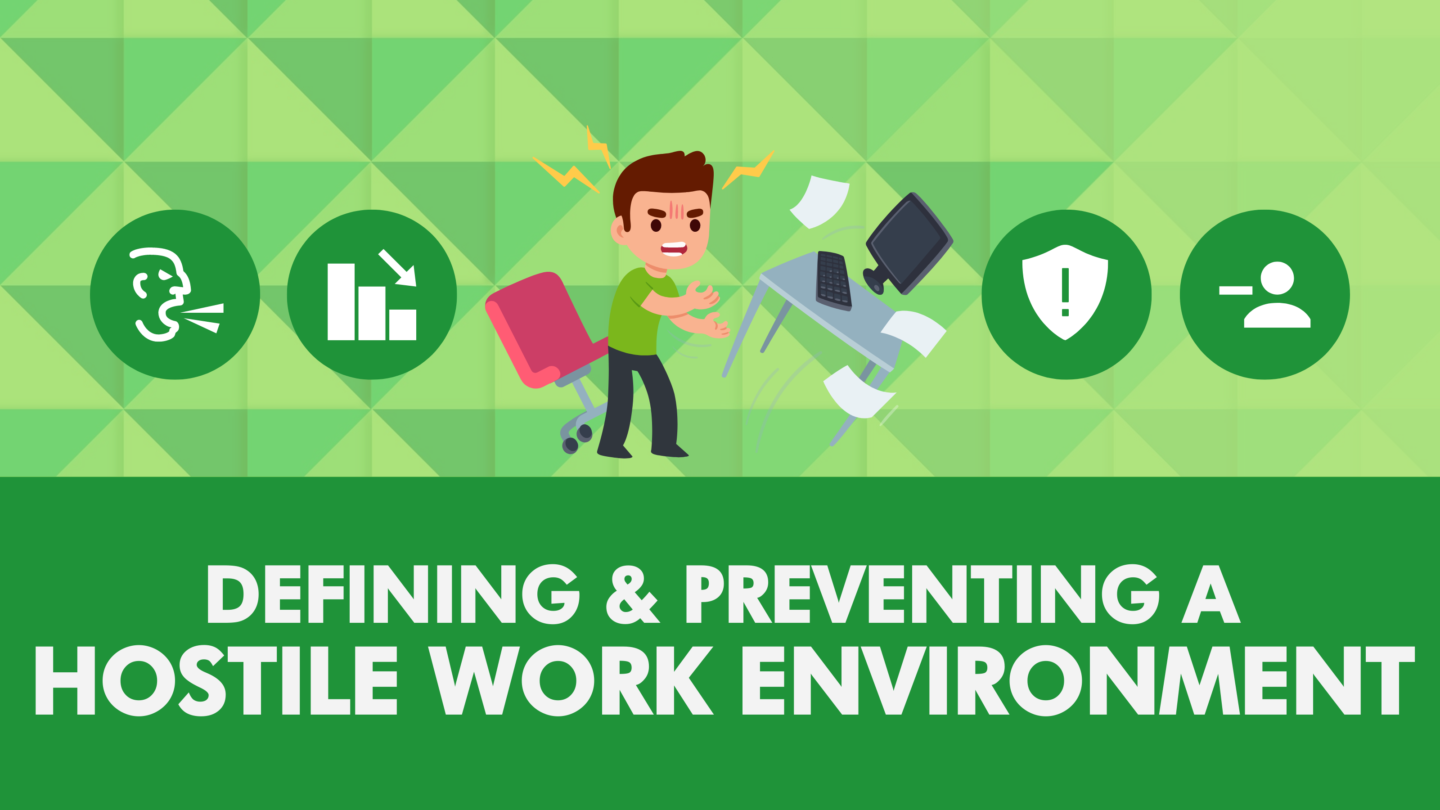
Defining & Preventing a Hostile Work Environment
Defining a Hostile Work Environment
To most people, a “hostile work environment” is a broad term that implies some sort of negativity associated with a workplace. While this assertion may be true, an ambiguous definition such as this makes it difficult to assess whether conditions are in fact hostile, and to what degree.
So what qualifies a workplace as hostile? Do the irritating remarks of your arch-nemesis / cubicle neighbor qualify? Does being bossed around by your boss day-in and day-out constitute a hostile work environment?
For a workplace to legally qualify as a hostile work environment, there must be;
Severe and recurring unwelcome conduct based on gender, sexual orientation, race, religion, age, country of origin, disability, or any other protected class*, that unreasonably interferes with an employee’s ability to perform their duty in a productive manner.
*Please note that legally protected classes may vary depending on the location of your workplace, so becoming familiar with the legislation and rules of your region is highly recommended.

Understanding the definition of a hostile work environment is an important first step to being able to identify and prevent such conditions from occurring.
Causes of a Hostile Work Environment
The most common contributing factors to the formation of a hostile work environment are as follows:
-
Sexual Harassment
Unfortunately, sexual harassment still exists in a number of workplaces. Any and all sexual harassment constitutes a hostile work environment. This includes inappropriate sexual innuendos, the sharing of sexually explicit content or images, as well as quid pro quo harassment whereby a sexual favor is offered in exchange for something.
-
Discrimination
Treating an employee in a negative or lesser way based on their sex, race, religion, age, country of origin, disability status, or any other protected class constitutes a hostile work environment. Discrimination is not always as blatant as an overtly sexist or racist remark. Denying an employee equal consideration for a promotion based on any of these classes would also qualify as discrimination.
-
Intimidation
Intimation serves not only to produce a hostile work environment, but also to sustain it. Both verbal and physical threats are forms of intimidation. If an employee has been subject to discrimination or harassment of any kind, but feels unable to report the incident due to a fear of consequence, this is a form of intimidation. An employee should never have to worry about their job security, their next bonus, potential negative social ramifications or retaliation when considering whether to file a complaint.
-
Unsafe Work Conditions
Employers are legally obligated to provide all employees with any and all necessary safety training and equipment, as well as to ensure that all equipment and safety protocols are up to date. Unsafe work conditions constitute a hostile work environment.
This is by no means a comprehensive list, as potential factors vary from workplace to workplace. Staying on top of all potential issues for your workplace is critical.
This is by no means a comprehensive list, as potential factors vary from workplace to workplace. Staying on top of all potential issues for your workplace is critical.
Toxic Employee Impacts Profits More Than a Superstar?
According to a Harvard Business School study, a “toxic employee” that contributes to the formation of a hostile work environment harms your company more than a superstar employee benefits it.
That is to say, avoiding the hiring of a “toxic employee” has greater impact on your bottom line than hiring an extremely productive “superstar employee”.
The take home message here is that “toxic employees” and the hostile work environment that they create have negative financial implications for the company as a whole.
You can access the full study here.

Preventing a Hostile Work Environment
There is a lot more to creating a positive and productive workplace than just the avoidance of the legal definition of a hostile work environment. Just because something doesn’t fall under the legal classification of hostile, doesn’t mean that it should be dismissed. A concerted effort to both prevent hostility, and promote positive, healthy working conditions should be continuously exercised.
Whether you’re looking to actively dissuade a hostile work environment by the legal definition, or are just trying to do everything you can to make your employees feel comfortable and content, here are some measures that you may choose to take;
1. Anti-Harassment Policy
Implement a policy that strictly prohibits all forms of harassment. Explicitly state that sexual harassment, discrimination based on gender, sexual orientation, race, religion, age, country of origin, disability, or any other protected classification, and intimidation of any kind will not be tolerated. Indicate that these types of behaviors may be grounds for disciplinary action, termination, and possibly criminal charges.
It’s important to be as clear as possible here, as this policy may take on an important role in a future complaint investigation and subsequent disciplinary action.
2. Provide Training / Education
Creating a thorough policy is one thing, making sure everyone understands it is another.
Managers and supervisors should be properly trained to observe and prevent harassment and hostility, and also to remain impartial to all employee conflict.
Employees may not be required to complete training that is as comprehensive as managers and supervisors, but they should be made to understand the basics. A simple, one-page handout that outlines “what is” and “what is not” acceptable is an easy and wide-reaching education strategy.
The key intent here is to eliminate any grey areas surrounding what is and what is not appropriate. Speaking of which...
3. Eliminate All Grey Areas
You don’t want your employees to think that they can never crack a joke or poke harmless fun at one another for fear of being reprimanded, but they should understand where the line is. By laying out what is deemed inappropriate, you can steer employees away from potentially hostile situations before things have a chance to escalate.
Beyond providing employees with a handout of your policies, it is good practice to make any and all-important information readily available and visible. Stick a copy of your harassment policy up in the break room, on a bulletin board, or in a common area. This serves as a gentle reminder, without the need for constant surveillance.

4. Complaint Procedure
We mentioned how intimidation can play a factor in an employee’s decision as to whether to file a complaint or not. Intimidation should never stop an employee from expressing an issue or concern that they have, and having a well-defined and effective complaint procedure in place is a great way to circumvent this issue.
In order to be effective, a complaint procedure should include:
A) More than one way to file a complaint.
If there is only one person designated to receive complaints, what happens if someone wishes to file a complaint about that person? It goes without saying that many employees would be discouraged from reporting a complaint in this regard. Supervisors and managers are not above the law, and it is for this reason that there should always be more than one means by which to file a complaint.
B) Prompt and discreet investigations.
After a complaint has been submitted, an investigation should be conducted without delay, in an unbiased and thorough manner. It is important that both sides of the story are examined with objectivity. Investigations should be performed in a discreet manner, not to discourage employees from coming forward with issues in the future.
C) A firm anti-retaliation policy.
Fear of retaliation is a major concern for any employee that wishes to have an issue addressed and can be seen as a form of intimidation. It should be made abundantly clear that retaliation of any kind will not be tolerated. If an employee makes a complaint, and the accused party retaliates, it serves not only prolong the conflict, but also to escalate the situation and promote a hostile work environment.
D) Swift and appropriate action taken.
It is in everyone’s best interest to resolve any conflict as soon as possible. If it is deemed that harassment of any kind has occurred or is continuing to occur, action must be taken immediately to eliminate the behavior. Taking action in a prompt manner is important, as it prevents the issue from potentially escalating or becoming a chronic problem.
Workplaces are dynamic and ever-changing, and so too is the need to actively combat the emergence of a hostile work environment.




